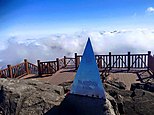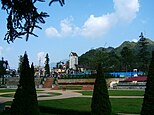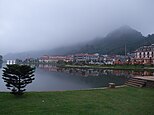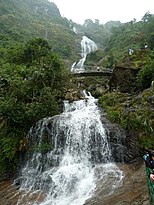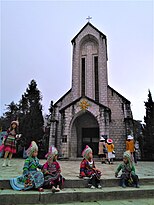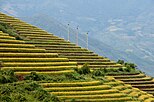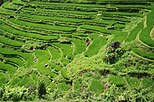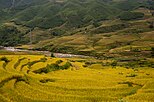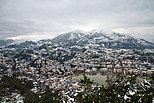Lào Cai province
Lào Cai | |
|---|---|
Fansipan aerial tramway • Phan Xi Păng • Topas tourist area • Bảo An Temple • Lào Cai Mountain • Lào Cai City • Hoàng A Tưởng House • Sa Pa Terrace • Sa Pa Mountain • Stone church in Sa Pa • Bạc Waterfall • snowfall at Sa Pa | |
 Location of Lào Cai within Vietnam | |
 | |
| Coordinates: 22°20′N 104°0′E / 22.333°N 104.000°E | |
| Country | |
| Region | Northwest |
| Capital | Lào Cai |
| Subdivision | 1 city, 7 rural districts and one town |
| Government | |
| • Type | Province |
| • Body | Lào Cai Provincial People's Council |
| • Chairman of People's Council | Nguyễn Văn Vịnh |
| • Chairman of People's Committee | Trịnh Xuân Trường |
| Area | |
• Province | 6,364.25 km2 (2,457.25 sq mi) |
| Population (2023)[2] | |
• Province | 781,103 |
| • Density | 120/km2 (320/sq mi) |
| • Urban | 181,019 |
| Ethnic groups | |
| • Vietnamese[3] | 33.78% |
| • Mông | 25.08% |
| • Tày | 14.83% |
| • Dao | 14.24% |
| • Giáy | 4.53% |
| • Others | 7.54% |
| GDP[4] | |
| • Province | VND 43.634 trillion US$ 1.895 billion |
| Time zone | UTC+7 (ICT) |
| Postal code | 31xxx |
| Area codes | 214 |
| ISO 3166 code | VN-02 |
| HDI (2020) | (47th) |
| Website | www |
Lào Cai is a province of the mountainous Northwest region of Vietnam bordering the province of Yunnan in China.[6] The province covers an area of about 6,364 km2 (2,457 sq mi)[1] and as of 2023 it had a population of 781,103 people. With 181,019 people living in urban areas and 562,382 living in rural areas.[7]
Lào Cai and Sa Pa are two important cities within the province at the border with China; the former is well known as key trading post and the latter is hill station famous for tourism, in the Northwest region of Vietnam. Lào Cai is also the capital of Lào Cai province and shares border with the city of Hekou, in the Yunnan province of Southwest China. This border town was closed after the 1979 war with China, since reopened in 1993, has become a major tourist centre between Hanoi, Sa Pa and Kunming (China). Sa Pa is notable as a hill resort and market centre for the local ethnic Hmong, including the Red, Black, Green and Flower Hmong. Located across the Muong Hoa Valley from Vietnam's highest mountain, Fansipan, the city is sometimes referred to as the "queen of mountains".[6][8][9]
Lào Cai has many historical sites, natural caves and produces agricultural specialties such as Bắc Hà plums.
In a 1929 survey conducted in the area, the vegetation (flora) and fauna (mammals) recorded by the French biologist Delacour who accompanied Theodore Roosevelt were unique to the region in northern Vietnam.[10]
Etymology
[edit]The name "Lao-Kay" has been used by the French since the colonial era in their writing, pronounced as "Lào Cai" by the Vietnamese. The latter became official usage and spelling after November 1950.[11]
The origin of the province's name is unclear and there are several explanations. The area in the ward of Cốc Lếu was the site of an old commercial district that developed into a market town. Because of this it was called Lão Nhai (老街, literally Phố Cũ, Old Town), in Hmong language it is pronounced as "Lao Cai". After this a new market town was developed and named Tân Nhai (新街, today Phố Mới, New Town). The word Lào Cai is sourced to "Lao Kai" which appeared as Jean Dupuis led a naval expedition up the Red River and in 1879 published the Map of Tonkin, in which the location was marked as "Lao-kai, residence du Chef des Pavillone noirs" (residence of the Head of Black Flag Army).[12] According to Professor Đào Duy Anh, it derives from the word "Lão Nhai". While making maps, the French wrote it as "Lao-Kay" and this word was used by them in documents. When reading, the Vietnamese pronounced it Lào Cai and this has persisted since.[11]
Geography and climate
[edit]
Lào Cai province is located in the north of the country and has an area of 6,364.25 km2 (2,457.25 sq mi).[1] It borders the provinces of Hà Giang, Yên Bái, and Lai Châu, as well as the province of Yunnan in the People's Republic of China.[13]
There are ten major soil groups under 30 categories in the province, under ten land groups. The land groups are: The Alluvial group (1.47% of the land area) along the Red River is good for growing food crops and trees; the Oxisol type which occupies 40% of land area has generally reddish brown soil, below altitude of 900 metres (3,000 ft), is a fertile land suitable for the annual and commercial crops; Team Red Yellow soil humus covers 30% land area in the Sa Pa, Mường Khương, Bắc Hà, Bát Xát districts of the province suitable for medicinal plants, fruit trees and vegetables; humus soil on the mountain occupies 11.42% of the land area mostly in Sa Pa district which has rich canopy of mixed forest; and the Oxisol color altered by rice in 2% of land area are formed into a landscape of terraced fields, as seen in Bắc Hà and Sa Pa districts.[14]
- Climate
As the province is mostly mountainous, it experiences a dry cold climate from October to March, while the tropical monsoon is rainy season, which lasts from April to September. The annual average temperature is 23 °C (73 °F). The temperature generally ranges between 18 °C (64 °F) and 28 °C (82 °F) in the lowland areas and between 20 °C (68 °F) and 22 °C (72 °F) in the highland areas. In Sa Pa town, however, the temperature can drop to less than 0 °C (32 °F) with snowy conditions. Fog and frost are a common phenomenon in the province.[6][13]
| Climate data for Lào Cai | |||||||||||||
|---|---|---|---|---|---|---|---|---|---|---|---|---|---|
| Month | Jan | Feb | Mar | Apr | May | Jun | Jul | Aug | Sep | Oct | Nov | Dec | Year |
| Record high °C (°F) | 31.4 (88.5) |
34.6 (94.3) |
38.0 (100.4) |
39.0 (102.2) |
42.8 (109.0) |
40.1 (104.2) |
39.7 (103.5) |
40.0 (104.0) |
36.8 (98.2) |
37.2 (99.0) |
33.2 (91.8) |
32.8 (91.0) |
42.8 (109.0) |
| Mean daily maximum °C (°F) | 20.1 (68.2) |
21.3 (70.3) |
25.3 (77.5) |
28.8 (83.8) |
32.1 (89.8) |
32.7 (90.9) |
32.7 (90.9) |
32.4 (90.3) |
31.3 (88.3) |
28.7 (83.7) |
25.1 (77.2) |
21.9 (71.4) |
27.7 (81.9) |
| Daily mean °C (°F) | 15.7 (60.3) |
17.0 (62.6) |
20.7 (69.3) |
24.2 (75.6) |
27.0 (80.6) |
27.9 (82.2) |
27.9 (82.2) |
27.5 (81.5) |
26.3 (79.3) |
24.0 (75.2) |
20.2 (68.4) |
17.0 (62.6) |
23.0 (73.4) |
| Mean daily minimum °C (°F) | 13.3 (55.9) |
14.5 (58.1) |
17.9 (64.2) |
21.1 (70.0) |
23.6 (74.5) |
24.7 (76.5) |
24.9 (76.8) |
24.4 (75.9) |
23.3 (73.9) |
21.2 (70.2) |
17.5 (63.5) |
14.3 (57.7) |
20.0 (68.0) |
| Record low °C (°F) | 1.4 (34.5) |
5.6 (42.1) |
6.8 (44.2) |
10.0 (50.0) |
14.8 (58.6) |
18.7 (65.7) |
20.0 (68.0) |
17.3 (63.1) |
15.8 (60.4) |
8.8 (47.8) |
5.8 (42.4) |
2.8 (37.0) |
1.4 (34.5) |
| Average precipitation mm (inches) | 22 (0.9) |
33 (1.3) |
58 (2.3) |
129 (5.1) |
171 (6.7) |
239 (9.4) |
302 (11.9) |
355 (14.0) |
222 (8.7) |
153 (6.0) |
54 (2.1) |
27 (1.1) |
1,764 (69.4) |
| Average rainy days | 7.8 | 8.8 | 11.5 | 15.8 | 16.8 | 18.7 | 20.9 | 21.1 | 15.8 | 14.8 | 10.2 | 7.7 | 169.8 |
| Average relative humidity (%) | 84.8 | 84.0 | 82.5 | 83.1 | 81.4 | 84.4 | 85.8 | 86.0 | 85.5 | 85.8 | 86.3 | 85.8 | 84.6 |
| Mean monthly sunshine hours | 80.4 | 76.9 | 105.0 | 144.9 | 189.2 | 148.9 | 166.6 | 168.1 | 162.5 | 129.9 | 105.4 | 110.6 | 1,588.4 |
| Source 1: Vietnam Institute for Building Science and Technology[15] | |||||||||||||
| Source 2: The Yearbook of Indochina [16] | |||||||||||||
| Climate data for Sa Pa | |||||||||||||
|---|---|---|---|---|---|---|---|---|---|---|---|---|---|
| Month | Jan | Feb | Mar | Apr | May | Jun | Jul | Aug | Sep | Oct | Nov | Dec | Year |
| Record high °C (°F) | 23.2 (73.8) |
25.8 (78.4) |
28.1 (82.6) |
29.8 (85.6) |
30.0 (86.0) |
29.4 (84.9) |
29.1 (84.4) |
29.6 (85.3) |
28.2 (82.8) |
26.4 (79.5) |
24.5 (76.1) |
24.0 (75.2) |
30.0 (86.0) |
| Mean daily maximum °C (°F) | 12.3 (54.1) |
14.3 (57.7) |
18.2 (64.8) |
21.3 (70.3) |
22.4 (72.3) |
22.9 (73.2) |
23.0 (73.4) |
23.0 (73.4) |
21.7 (71.1) |
19.0 (66.2) |
16.1 (61.0) |
13.2 (55.8) |
18.9 (66.0) |
| Daily mean °C (°F) | 8.6 (47.5) |
10.4 (50.7) |
13.9 (57.0) |
17.1 (62.8) |
18.9 (66.0) |
19.8 (67.6) |
19.8 (67.6) |
19.5 (67.1) |
18.2 (64.8) |
15.7 (60.3) |
12.5 (54.5) |
9.4 (48.9) |
15.3 (59.5) |
| Mean daily minimum °C (°F) | 6.2 (43.2) |
7.8 (46.0) |
10.8 (51.4) |
14.0 (57.2) |
16.3 (61.3) |
17.6 (63.7) |
17.7 (63.9) |
17.4 (63.3) |
15.9 (60.6) |
13.7 (56.7) |
10.2 (50.4) |
7.0 (44.6) |
12.9 (55.2) |
| Record low °C (°F) | −6.1 (21.0) |
−1.3 (29.7) |
−3.5 (25.7) |
3.4 (38.1) |
8.3 (46.9) |
10.8 (51.4) |
7.0 (44.6) |
10.4 (50.7) |
8.7 (47.7) |
5.6 (42.1) |
1.0 (33.8) |
−3.2 (26.2) |
−6.1 (21.0) |
| Average precipitation mm (inches) | 70.2 (2.76) |
73.5 (2.89) |
104.5 (4.11) |
213.4 (8.40) |
340.6 (13.41) |
381.4 (15.02) |
461.0 (18.15) |
451.9 (17.79) |
303.1 (11.93) |
201.3 (7.93) |
106.3 (4.19) |
65.7 (2.59) |
2,779.6 (109.43) |
| Average rainy days | 16.3 | 16.3 | 15.7 | 17.9 | 22.2 | 24.4 | 25.6 | 23.4 | 19.8 | 18.6 | 13.8 | 13.5 | 228.1 |
| Average relative humidity (%) | 87.8 | 85.5 | 82.1 | 82.3 | 84.8 | 86.9 | 88.3 | 88.8 | 90.0 | 90.8 | 80.5 | 80.3 | 87.2 |
| Mean monthly sunshine hours | 113.3 | 115.6 | 151.2 | 167.8 | 148.1 | 98.9 | 104.1 | 114.2 | 101.7 | 94.0 | 112.5 | 121.0 | 1,435.9 |
| Source 1: Vietnam Institute for Building Science and Technology[17] | |||||||||||||
| Source 2: The Yearbook of Indochina[18] | |||||||||||||
- Water resources
Lào Cai is a mountainous region. In the northwest of the province is Phan Xi Păng (also called Fansipan; elevation 3,143 metres (10,312 ft), snow covered during winter season), Vietnam's highest mountain. It is located in the Hoàng Liên Sơn and the Hoàng Liên National Park. The Sa Pa Mountains form the western part of the province. While the province is drained by over 100 rivers, the main river that bisects the province is the Red River, (Vietnamese: Sông Hồng), the most significant river of northern Vietnam, which flows out of China towards the capital Hanoi. It flows through the province over a length of 130 kilometres (81 mi). Other rivers of significance are the Chay and Nam Ti Rivers. Much of the province is heavily forested.[13]
Ground water resources have been estimated reserves as 4,448 million cubic metres out of which good quality water is estimated as 30 million cubic metres. In addition, there are four mineral water sources.[14]
- Mineral resources
The province has rich mineral resources, 30 types have been identified with good reserves. The major valuable mineral reserves are: Copper (53 million tons), molybdenum (15 million tons), apatite and iron (2.5 billion tons). There are 150 mines in the province exploiting various minerals.[14]
Flora and fauna
[edit]Forests account for 2,789.07 kilometres (1,733.05 mi), accounting for 43.87% of the province's area, of which 2,292.97 kilometres (1,424.79 mi) is natural while the remainder is plantation forestry. The forests feature 442 species, including various types of birds, insects and frogs. The province has a rich forest reserve known for its many species of rare timber plants; some of the well known species are: po mu (fukiena), lat hoa (chukrasia tabularis), and cho chi, apart from many species of medicinal herbs.[6]
In the Fansipan mountain ranges, vegetation varies with altitude, with elevation above 1,500 metres (4,900 ft) retaining the forests. In the elevation range of 2,500–2,800 metres (8,200–9,200 ft), which is the mist area, "elfin forest" is the dominant forest vegetation of "gnarled trees (Tsuga yunanaris)" of less than 8 metres (26 ft) height covered with moss. Above 2,800 metres (9,200 ft) elevation, the mountain range has undersized vegetation with many bamboos and rhododendrons.[10]
The Hoang Lien National Park has only 12 square kilometres (4.6 sq mi) of forest left as a result of anthropogenic pressure over centuries. Grass, bushes and small trees are seen on the land which are devoid of forests, and large areas are used for cultivation; ginger plantation, as a cash crop is widespread.[10]
According to a 1929 survey conducted in the area, the fauna (mammals) recorded by the French biologist Delacour who accompanied Theodore Roosevelt were: the clouded leopard (Neofelis nebuiosa), leopard (Panthera pardus), tiger (panthera tigris), binturong (Arctictus binturong) and black gibbon (Hylobates concolor), the stump-tailed macaque (Macaca arctoides), and Asiatic black bear (Selenarctos thibetanus). In Sa Pa forests, 150 species of birds were recorded such as the red-vented barbet ( Megalaima lagrandieri), collared finchbill (Spizixo semitoroues), white-throated laughingthrush (Garrulax albogularis) and the chestnut bulbul (Hypsipetes castanotus); all species are considered exclusive to North Vietnam.[10]
History
[edit]

Lào Cai has been known since ancient times as a historic trading post. Here, the Chinese, the Vietnamese and the ethnic minorities of the region fought to gain control of the region. In 1463, the Viet Kings established Lào Cai as the capital of their northernmost region, then named as Hưng Hóa. It came under French colonial rule in 1889 and was their administrative town, and also served as a military garrison. In the early 19th century the first railway line was built from Hanoi to this region. It took seven years to complete but at the cost of 25,000 lives of Vietnamese people who were conscripted labourers.[19]
In late 1978, the Vietnamese invaded Cambodia due to constant attacks resulting in massacres from the genocidal Khmer Rouge on Vietnamese soil. The Chinese, as allies of the Khmer Rouge invaded North Vietnam with the aim of "teaching the Vietnamese a lesson" to withdraw from Cambodia. The attack was launched by 200,000-600,000 People's Liberation Army personnel. They occupied territory from Paso (previously known as Phon Tho) in the Northwest to Cao Bằng and Lạng Sơn in the Northwest. The Chinese suffered heavy casualties, but managed to take these cities due to fighting being done against primarily Vietnamese militia units and local border troops, with the core fighting element of Vietnamese army all being stationed in Cambodia. China decided to withdraw completely after less than a month and claimed that ‘the gate to Hanoi was open’ and that ‘their punitive mission had been achieved’. On the way back to the Chinese border, the PLA destroyed local infrastructure and homes, looted equipment and resources including livestock, weakening the already destabilised post-Vietnam War economy of Vietnam's northernmost provinces. The PLA completely pulled out on March 16. Both sides declared victory with China claiming their ‘mission was successful’ and Vietnam successfully repelling a Chinese Invasion. Following the invasion, the border with China was closed for several years. The city of Lào Cai was devastated by the Chinese. The war also resulted in the planting of land mines that continue to inflict casualties along the border with China.[20][21]
The border town of Lào Cai, which lies along the Red River and is the provincial capital has now prospered due to trade with China and is a booming city with a community of millionaires. Since 2006, Lào Cai has had city status and is the largest town in the region. An airport is planned to be built by 2020.[19][22]
Administrative divisions
[edit]Lào Cai is subdivided into 9 district-level sub-divisions:
| Second-tier subdivisions |
Area (km2) |
Third-tier subdivisions | ||
|---|---|---|---|---|
| Ward | Township | Commune | ||
| Lào Cai city | 229.67 | 12 | 5 | |
| Bắc Hà District | 686.78 | 1 | 20 | |
| Bảo Thắng District | 691.55 | 3 | 12 | |
| Bảo Yên District | 820.00 | 1 | 17 | |
| Bát Xát District | 1050.00 | 1 | 22 | |
| Mường Khương District | 556.15 | 1 | 15 | |
| Sa Pa town | 683.29 | 6 | 10 | |
| Si Ma Cai District | 234.54 | 13 | ||
| Văn Bàn District | 1422.00 | 1 | 22 | |
They are further subdivided into 8 commune-level towns (or townlets), 144 communes, and 12 wards.[23]
Table of local government divisions
[edit]| Name | Division type | Population (2003) | Area (km2) | Towns (huyện lỵ or thị trấn) (bold) and communes (xã) |
|---|---|---|---|---|
| Lào Cai | City (thành phố) | 94,192 | 221.5 | Wards (phường): Phố Mới, Duyên Hải, Cốc Lếu, Kim Tân, Pom Hán, Bắc Lệnh, Thống Nhất, Xuân Tăng, Bắc Cường, Nam Cường, Bình Minh. Communes (xã): Vạn Hòa, Đồng Tuyển, Cam Đường, Tả Phời, Hợp Thành |
| Bắc Hà District | District (huyện) | 48,988[24] | 680[24] | Bắc Hà, Bản Phố, Bản Liền, Bản Già, Bảo Nhai, Bản Cái, Cốc Ly, Cốc Lầu, Nậm Mòn, Nậm Khánh, Nậm Đét, Na Hối, Lầu Thí Ngài, Lùng Phìn, Lùng Cải, Tả Củ Tỷ, Tả Van Chư, Tà Chải, Thải Giàng Phố, Hoàng Thu Phố, Nậm Lúc. |
| Bảo Thắng District | District (huyện) | 107,174[24] | 674[24] | Phố Lu, Phong Hải, Tằng Loỏng, Phú Nhuận, Phố Lu, Sơn Hà, Trì Quang, Xuân Quang, Phong Niên, Xuân Giao, Gia Phú, Sơn Hải, Thái Niên, Bản Cầm, Bản Phiệt. |
| Bảo Yên District | District (huyện) | 73,924[24] | 821[24] | Phố Ràng, Long Khánh, Long Phúc, Việt Tiến, Lương Sơn, Yên Sơn, Xuân Thượng, Minh Tân, Bảo Hà, Cam Con, Kim Sơn,Điện Quan,Thượng Hà,Tân Dương,Xuân Hòa,Vĩnh Yên,Nghĩa Đô,Tân Tiến. |
| Bát Xát District | District (huyện) | 62,477[24] | 1050[24] | Bát Xát, Cốc San, Tòng Sanh, Phìn Ngan,Quang Kim,Bản Qua,Mường Vị, Bản Vược,Bản Xèo, Pa Cheo, Nậm Pung,Trung Lènh Hồ, Mường Hum, Dền Thàng, Sáng Ma Sáo, Dền Sáng,Cốc Mỳ, Y Tý, Ngải Thầu,A Lù,A Mú Sung,Nậm Chạc,Trịnh Tường. |
| Mường Khương District | District (huyện) | 48,242[24] | 552[24] | Mường Khương, Lào Ca, Cao Sơn, Bản Lầu, Nậm Chảy, Tung Chung Phố, Tả Gia Khâu, Pha Long, Dìn Chin, Tả Ngải Chồ, Thanh Bình, Bản Sen, Lùng Khấu Nhin, La Pan Tẩn, Nấm Lư, Tả Thàng, Lùng Vai. |
| Sa Pa Town | Town (thị xã) | 42,095[24] | 677[24] | Wards (phường): Cầu Mây, Hàm Rồng, Ô Quý Hồ, Phan Si Păng, Sa Pa, Sa Pả
Communes (xã): Bản Hồ, Hoàng Liên, Liên Minh, Mường Bo, Mường Hoa, Ngũ Chỉ Sơn, Tả Phìn, Tả Van, Thanh Bình and Trung Chải. |
| Si Ma Cai District | District (huyện) | 25,554[24] | 241[24] | Si Ma Cai, Thào Chư Phìn, Bản Mế, Sán Chải, Lùng Sui, Mản Thẩn, Cán Hồ, Sín Chéng, Lử Thẩn, Quan Thần Sán, Cán Cấu, Nàn Sín, Nàn Sán. |
| Văn Bàn District | District (huyện) | 73,183[24] | 557.5[24] | Khánh Yên, Văn Sơn, Võ Lao, Tân An, Tân Thượng, Nậm Mả, Nậm Rạng, Nậm Tha, Liêm Phú, Chiềng Ken, Sơn Thủy, Khánh Yên Hạ, Khánh Yên Trung, Khánh Yên Thượng, Làng Giàng, Hòa Mạc, Dần Thàng, Dương Qùy, Nậm Chày, Thẳm Dương, Minh Lương, Nậm Xây, Nậm Xé. |
Economy
[edit]
Traditional economic activities such as agriculture and forestry remain important, but the province has also been attempting to develop foreign investment in the area. Cross-border trade with China is also a growing source of income, as is tourism centred on trekking up the peak of Fansipan, Vietnam's highest mountain. Ecotourism is gaining ground. Agriculture and forestry constitute 78.07% of economic activity; fishing and aquaculture 0.04%, mining 1.62%; manufacturing 2.37%, power and water 0.22%, construction 3.29%, repairmen 3.48%; hospitality 0.90%, communications 1.31%; finance 0.21%, science and technology 0.05%;, education and research 3.57%; health and social work 0.69%; cultural activities 0.24% and several other small sectors.
As against the national figure of 7,592 cooperatives, there are 19 cooperatives in the province, out of which 17 are agricultural cooperatives and one is a fisheries cooperative.[25][26] There are only 253 farms as compared to the national number of 120,699.[27] The output value of agriculture produce at constant 1994 prices in the province was 663 billion đồngs against the national value of 156,681.9 billion đồngs.[28]
In 2008, the province produced 199,800 tonnes of cereals compared to the national production of 43.68 million tonnes.[29] The per capita production of cereals in the province was 491.4 kilograms (1,083 lb) as against the national figure of 331.7 kilograms (731 lb) in 2008.[30]
In 2007, the industrial output of the province was a meagre 1,916.2 bill. đồngs against the national output of 1.47 million billion đồngs.[31]
Lào Cai has 150 mines or mining locations of 30 different categories, some of which are the largest of their kind in the country. These include the apatite mine at Cam Đường with 2.5 billion tonnes, the iron mine at Quý Xa with 124 million tons, the copper mine at Sin Quyền with 53 million tons, the molybdenum mine at Ô Quy Hồ with 15,400 tons.
In recent years the government of Vietnam has encouraged reforestation in the province, because of the importance of wood for fuel and development and for environmental reasons. Tree planting has been ordered particularly in Sa Pa.
Demographics
[edit]
With more than 20 ethnic groups, Lào Cai is a melting pot of cultures and history. Ethnic Vietnamese are the majority, especially since 1960 when the North Vietnamese government followed a policy of settling communist party cadres from lowland areas in upland areas, then predominantly occupied by tribes. According to the General Statistics Office of the Government of Vietnam, the population of Lào Cai province, as of 2008, was 602,300 with a density of 94 persons per square kilometre over a total land area of 6,383.9 square kilometres (2,464.8 sq mi) of the province.[32] The male population during this period was 303,300[33] with females accounting for 299,000.[34] The urban population was 125,900 against an urban population of 476,400 (about 25% of the rural population).[35][36]
The province has 25 of Vietnam's ethnic minority groups accounting for 64.09% of its population. The largest ethnic groups are: Vietnamese - 35.9%, Hmong - 22.21%, Tay - 15.84%, Dao -14.05%, Giay - 4.7%, Nùng 4.4% and the others belong to Phu La, San Chay, Ha Nhi, and the La Chi groups.[37]
Languages, other than Vietnamese, spoken in Lào Cai province include the following.
- Hmong–Mien languages
- Hmong
- Kim Mun
- Tai languages
- Nùng
- Tày (Tày Sa Pa, etc.)
- Giáy (Bouyei) - Bát Xát District, Mường Khương District, Bảo Yên District
- Tibeto-Burman languages
Hoàng Liên National Park
[edit]The Hoàng Liên National Park is located within the province and was upgraded from a nature reserve in 2006. It covers an area of 24.66 square kilometres (30 km2 is also mentioned in some references) and contains the peak of Fan Si Pan, which, at 3,143 metres (10,312 ft), is the highest peak in Vietnam. The park contains heavy forests and a rich biodiversity, although because of agricultural production of ginger and other land uses, today only about 12 kilometres (7.5 mi) of the park is forested. 1884 migrating raptors have been recorded in the national park, which is stated to be a rarity in terms of numbers and the species varieties. The area was surveyed by French biologist Delacour in 1929 who had accompanied Theodore Roosevelt to an expedition in southeast Asia. He collected 48 mammal species for the Chicago Natural History Museum although most were shot. Sediments in the park date back to the Mesozoic era, whilst the granite is a Palaeocene intrusion. The northwestern boundary of the national park is made with a rugged boundary of marble and metamorphosed calcium carbonate.[10][38][39]
Transport
[edit]Lào Cai is one of the few mountainous provinces with well-developed transport networks consisting of roads, rail and waterways. An airport is planned in Bao Yen District.[40] The provincial city is connected by road, rail and river transport links with Hanoi on its northwest (340 kilometres (210 mi)) and to Yunnan province in China. Within the province, road links exist to Sa Pa and Bắc Hà. The Haiphong railway to Yunnan is of strategic importance. There are four national highways totaling to a length of 400 km, provincial roads of about 300 km length and 1,000 km of village roads.[6][41]
The Hanoi–Lào Cai railway is 296 kilometres (184 mi), of which 62 kilometres (39 mi) is in the province, and links to Chinese railways at the border. It can carry 1 billion tonnes of freight per year and thousands per day. Plans for a high-speed rail link between Hanoi and Lào Cai has been investigated by the Ministry of Transport and the Asian Development Bank. This is expected to create a high-speed rail corridor from Kunming – Lào Cai – Hanoi – Haiphong.
Red River flowing through the province provides water transport facilities though its transportation capacity is limited.[41] The planned Sapa Airport Project was approved by the government of Vietnam and will be built in this province in the Q4/2021.
Visitor attractions
[edit]As Lào Cai province is mountainous and still developing, its natural environment is relatively environmentally unspoilt. This means that its potential as an ecotourism destination among Vietnamese and foreigners is still intact. It has now become popular and a novel experience among both Chinese and Vietnamese as a tourist destination, particularly a "sexualized and sensualised" border town of Lào Cai. Special border travel packages for tourists, arranged between China and Vietnam under the present political set up in Vietnam, has relaxed regulations permitting tourists to visit selected locations under conducted tours to places in Northern Vietnam and particularly to the provincial headquarter of Lào Cai; Lào Cai is the last stop before crossing into China on way to Kunming across the border, which lies at the end of the train line to China. Since then the Chinese tourists visiting Lào Cai on a one-day trip or two days trip including the hill station town of Sa Pa in the province (a popular five trip is also organized covering Lào Cai, Hanoi, Hạ Long and Hai Phong) recorded a quantum jump, from 4200 in 1995 to 176,310 in 2002. Lào Cai is popular among Chinese travellers (males, in particular) who are said to be "obsessed with Zhao Xiaojie ("looking for misses") for its sex market. A male tourist from China made a mention: "There is a common saying in China: Vietnam sacrifices one generation of young women for the well-being of the next three generations."[8][42] A popular motorbiking route among tourists that covers the mountainous region of the province known as the "Tonkinese Alps", is to start from the White Thai villages, Sơn La, historic site of Dien Bien Phu and terminating at Sa Pa.[8]
Sa Pa is one of 21 national tourism areas in Vietnam. Sa Pa is at an altitude of 1,200–1,800 metres (3,900–5,900 ft), has a mild climate throughout the year, lush, forested and mountainous scenery, waterfalls and is a hub of cultural activities of various ethnic minorities in the region, such as the Hmong and Dao people used to gather during the weekly market to "attend an ephemeral "Love Market" where young men and women chose partners to marry. It is 38 km away from the border town of Lào Cai. Visit to Sapa town is said to be more popular among visitors from Western countries in view of its attraction of ethnic tribals.[8][42][43] In fact, the French had established a Travel Bureau, as early as 1917, and the town was popular among the "French colonist" all through their rule as a hill resort. However, Sa Pa has gone through several rounds of destruction between 1947 and 1953, and again in 1979 due to war with French and Chinese. It has been partly restored and has gradually become a tourist hub since the region was opened to tourism in 1993. A good time to visit Sa Pa would be when rice fields in different green shades are being harvested in the fall season (September to November). The colours of the rice fields indicate the time for harvesting various plots. The women of the ethnic minority tribes who harvest the crops on the fields further accentuate the different green shades of the fields with their eye-catching red and indigo-coloured dresses.[44]
Lào Cai has many historic sites, natural caves and produces agricultural specialties such as Bắc Hà plums.
See also
[edit]References
[edit]- ^ a b c Biểu số 4.1: Hiện trạng sử dụng đất vùng Trung du và miền núi phía Bắc năm 2022 [Table 4.1: Current land use status in the Northern Midlands and Mountains in 2022] (PDF) (Decision 3048/QĐ-BTNMT) (in Vietnamese). Ministry of Natural Resources and Environment (Vietnam). 18 October 2023. – the data in the report are in hectares, rounded to integers
- ^ a b General Statistics Office of Vietnam (2019). "Completed Results of the 2019 Viet Nam Population and Housing Census" (PDF). Statistical Publishing House (Vietnam). ISBN 978-604-75-1532-5.
- ^ Also called Kinh people
- ^ "Tình hình kinh tế, xã hội Lào Cai năm 2018". UBND tỉnh Lào Cai. Retrieved 10 May 2020.
- ^ "Human Development Index by province(*) by Cities, provincies and Year". General Statistics Office of Vietnam. Retrieved September 28, 2024.
- ^ a b c d e "Lao Cai". Vietnam.Sawadee. Archived from the original on 2016-03-03. Retrieved 2010-07-25.
- ^ "Population and population density in 2008 by province". General Statistics Office of Vietnam. Archived from the original on November 13, 2009. Retrieved September 5, 2010.
- ^ a b c d Ray, Nick (2009). Cambodia Laos & the Greater Mekong. Lonely Planet. p. 383. ISBN 978-1-74179-174-7. Retrieved 2010-08-31.
- ^ "Lao Cai". Encyclopædia Britannica. Retrieved 2010-07-25.
- ^ a b c d e "Fauna and Flora". Tpoas Ecolodge. Archived from the original on 2011-07-17. Retrieved 2010-09-02.
- ^ a b "History of Lao Cai". Government of Vietnam. Retrieved 2010-09-01.
- ^ Tonkin Map 1879, in Il était un Tonkin: Jean Dupuis Archived 2015-12-22 at the Wayback Machine. forez-info, 2012. Retrieved 22/12/2015.
- ^ a b c "Natural resources". Lào Cai: Government of Vietnam. Retrieved 2010-08-29.
- ^ a b c "Natural resources". Lào Cai: Government of Vietnam. Retrieved 2010-08-29.
- ^ "Vietnam Building Code Natural Physical & Climatic Data for Construction" (PDF). Vietnam Institute for Building Science and Technology. Archived from the original (PDF) on 22 July 2018. Retrieved 3 August 2018.
- ^ Archived copy Archived 10 May 2021 at the Wayback Machine
- ^ "QCVN 02:2022/BXD Quy chuẩn kỹ thuật quốc gia về Số liệu điều kiện tự nhiên dùng trong xây dựng" (in Vietnamese).
- ^ Archived copy Archived 10 May 2021 at the Wayback Machine
- ^ a b Boobbyer, Claire (2008). Footprint Vietnam. Footprint Travel Guides. pp. 119–120. ISBN 978-1-906098-13-1. Retrieved 2010-08-29.
- ^ "Lao-Cai Lao Cai". Britannica Online Encyclopedia.
- ^ "Provinces of North East Region: Lao Cai Province". Wompom. Retrieved 2010-07-25.
- ^ Merriam-Webster's geographical dictionary. Merriam-Webster. 1997. p. 628. ISBN 0-87779-546-0. Retrieved 2010-08-29.
- ^ "Number of administrative units as of 31 December 2008 by province". General Statistics Office of the Government of Vietnam. Archived from the original on 13 November 2010. Retrieved 2010-06-23.
- ^ a b c d e f g h i j k l m n o p "Districts of Vietnam". Statoids. Retrieved June 20, 2010.
- ^ "Agriculture, Forestry and Fishery: Number of cooperatives by province". Population and Employment :General Statistics Office of the Government of Vietnam. Archived from the original on 2009-11-13. Retrieved 2010-06-23.
- ^ "Number of cooperatives in 2008 by kind of activity and by province: Agriculture, Forestry and Fishery". Population and Employment :General Statistics Office of the Government of Vietnam. Archived from the original on 2009-11-13. Retrieved 2010-06-23.
- ^ "Agriculture, Forestry and Fishery: Number of farms by province". Population and Employment :General Statistics Office of the Government of Vietnam. Archived from the original on 2009-11-13. Retrieved 2010-06-23.
- ^ "Agriculture, Forestry and Fishery :Output value of agriculture at constant 1994 prices". Population and Employment :General Statistics Office of the Government of Vietnam. Archived from the original on 2009-11-13. Retrieved 2010-06-23.
- ^ "Agriculture, Forestry and Fishery:Production of cereals by province". Population and Employment :General Statistics Office of the Government of Vietnam. Archived from the original on 2009-11-13. Retrieved 2010-06-23.
- ^ "Agriculture, Forestry and Fishery:Production of cereals per capita by province". Population and Employment: General Statistics Office of the Government of Vietnam. Archived from the original on 2009-11-13. Retrieved 2010-06-23.
- ^ "Industry: Industrial output value at current prices by province". Population and Employment: General Statistics Office of the Government of Vietnam. Archived from the original on 2009-08-31. Retrieved 2010-06-23.
- ^ "Population and population density in 2008 by province". General Statistics Office of the Government of Vietnam. Archived from the original on 2009-11-13. Retrieved 2010-06-23.
- ^ "Population and Employment :Average male population by province". Population and Employment :General Statistics Office of the Government of Vietnam. Archived from the original on 2009-11-13. Retrieved 2010-06-23.
- ^ "Average female population by province". General Statistics Office of the Government of Vietnam. Archived from the original on 2009-11-13. Retrieved 2010-06-23.
- ^ "Average urban population by province". Population and Employment :General Statistics Office of the Government of Vietnam. Archived from the original on 2014-10-12. Retrieved 2010-06-23.
- ^ "Average rural population by province". Population and Employment: General Statistics Office of the Government of Vietnam. Archived from the original on 2009-11-13. Retrieved 2010-06-23.
- ^ "Population, ethnic administrative institutions". Lao cai: Government of Vietnam. Retrieved 2010-08-29.
- ^ "Raptor migration at Hoang Lien Nature Reserve, northern Vietnam" (PDF). Oriental Bird Club. Archived from the original (PDF) on 2011-06-10. Retrieved 2010-09-02.
- ^ "fauna and flora". Mammals. Tripadviser. Archived from the original on 2012-11-26. Retrieved 2010-09-02.
{{cite web}}: CS1 maint: bot: original URL status unknown (link) - ^ "Sa Pa Airport to be smaller, cost estimate almost halved". VnExpress International. Retrieved 2021-05-10.
- ^ a b "Infrastructure". Lao cai: Government of Vietnam. Retrieved 2010-08-29.
- ^ a b Hitchcock, Michael (2009). Tourism in Southeast Asia: challenges and new directions. NIAS Press. pp. 206–212. ISBN 978-87-7694-034-8. Retrieved 2010-08-31.
- ^ Michaud, Jean, Turner, Sarah (2006). "Contending of a hill station" (PDF). Annals of Tourism Research. Canada. Retrieved 2010-08-25.
{{cite web}}: CS1 maint: multiple names: authors list (link) - ^ Pham, Sherisse (2008). Frommer's Vietnam. Frommer's. p. 148. ISBN 978-0-470-19407-2. Retrieved 2010-08-29.
External links
[edit]- Lao Cai Provincial Government website (in Vietnamese)


